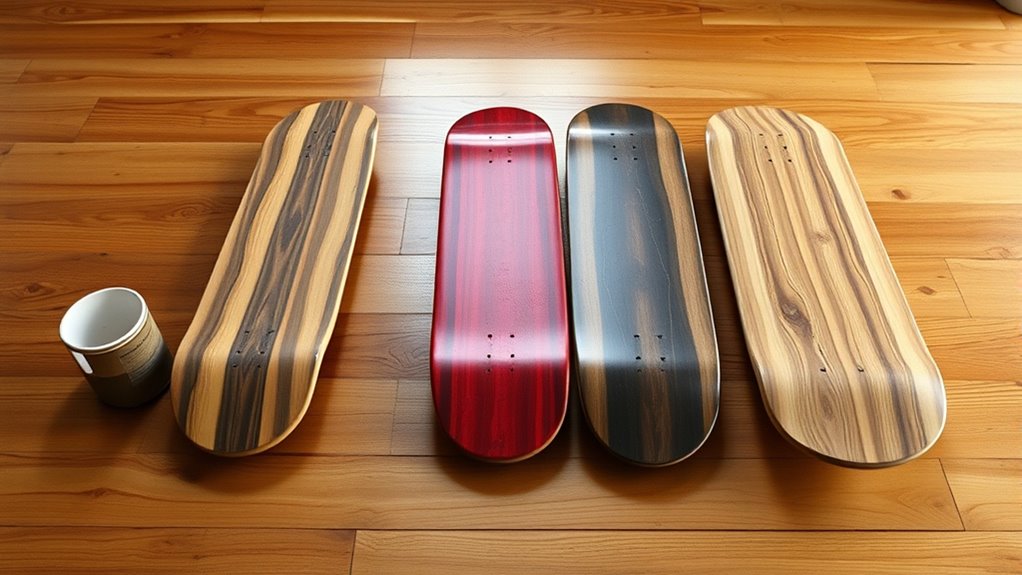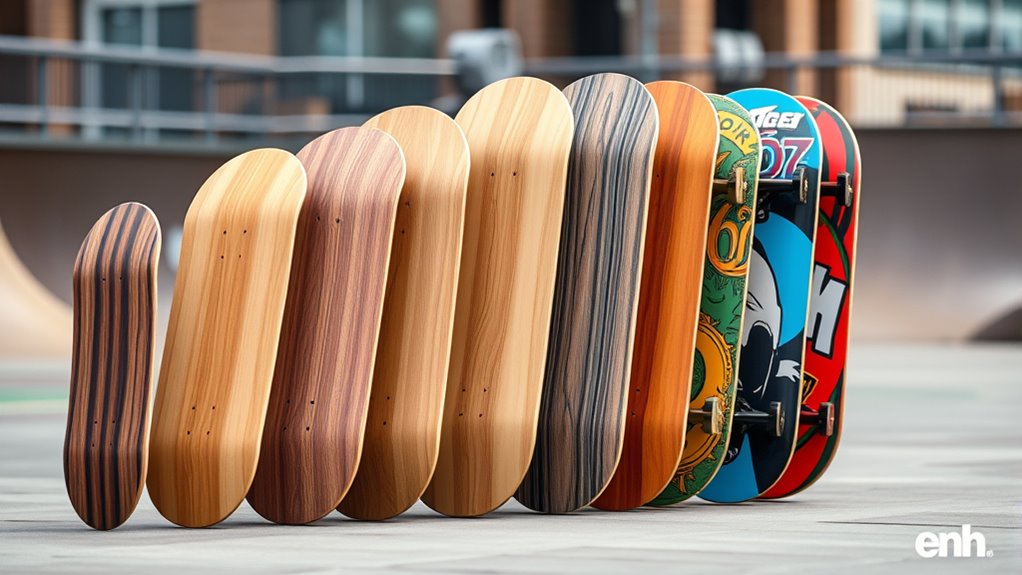Skateboard deck shapes have evolved to optimize your performance based on your riding style. Narrow decks (7.5-8 inches) give you agility for street tricks, while wider decks (8.25 inches and above) offer stability for vert or bowl riding. Longer decks provide a solid platform for cruising, and shorter ones allow quick, responsive flicks. Understanding how deck width, length, and contour influence tricks can help you choose the perfect setup—if you keep exploring, you’ll uncover even more about maximizing your skateboarding skills.
Key Takeaways
- Skateboard deck shapes have evolved from traditional popsicle styles to specialized forms for different riding styles.
- Changes in deck width and length influence trick execution, control, and overall maneuverability.
- Narrower decks enhance technical street tricks, while wider decks improve stability for vert and bowl riding.
- Longer decks provide a stable platform for cruising and trick progression, whereas shorter decks allow quick, responsive moves.
- Modern deck designs prioritize performance by tailoring dimensions to specific disciplines, enhancing rider confidence and skill development.

Choosing the right skateboard deck shape is essential because it directly influences your riding style and performance. One of the first things you’ll notice when selecting a deck is the variety of deck width variations. The width affects how stable your ride feels and how easily you can control your tricks. Narrow decks, typically around 7.5 to 8 inches, are more maneuverable and better suited for technical street skating. They allow for quick flicks and precise foot placements, making them ideal for flip tricks and technical maneuvers. On the other hand, wider decks—8.25 inches and above—offer more stability, which is beneficial for vert skating, bowl riding, or cruising. They provide a larger platform for landings and help keep your balance during high-speed pursuits. Your choice in deck width should align with your preferred style and comfort, as it influences how you execute tricks and maintain control.
In addition to width, deck length plays a significant role in shaping your skating experience. Longer decks, generally exceeding 32 inches, give you a more stable platform, which is advantageous for cruising or progressing between tricks smoothly. They also provide more room for foot placement, making it easier to land and hold tricks like manuals or grinds. Shorter decks, around 28 to 30 inches, are more responsive and allow for quicker turns, which is perfect for street skating where agility is key. The impact of deck length on your tricks is substantial; a shorter deck can make flip tricks feel more controlled and snappy, while a longer deck can help maintain stability during complex tricks or when landing from higher jumps. Both width and length combine to influence your overall balance, control, and comfort, so understanding their impact helps you choose a deck that complements your skill level and style.
Over time, skateboard designs have evolved to cater to specific riding disciplines, but the core principles of deck width variations and deck length impact remain central. Whether you’re aiming for technical street tricks, vert stunts, or cruising, recognizing how these dimensions shape your ride is fundamental. The right deck shape doesn’t just look good; it enhances your ability to perform tricks with confidence and precision. As you experiment with different sizes and shapes, you’ll discover what feels most natural and effective for your style. Remember, your choice in deck shape is a foundation for your progression, so take the time to select one that aligns with your goals and comfort. Understanding the importance of deck dimensions and their influence on your riding experience helps you make smarter decisions, leading to better tricks, more control, and a more enjoyable skateboarding journey.
Frequently Asked Questions
How Do Different Deck Shapes Influence Board Durability?
Different deck shapes can substantially influence board durability. You’ll notice that material durability varies with the type of wood or composite used, affecting how long your deck lasts. Flexibility variations also play a role; a more flexible deck can absorb impacts better, reducing cracks and breakage. Choosing the right shape and materials based on your riding style helps guarantee your board withstands tricks and daily wear, lasting longer and performing better.
Can Deck Shape Changes Improve Beginner Trick Performance?
Changing your deck shape can definitely help improve your beginner tricks like pop shuvits and ollies. A deck with a slightly wider nose and tail gives you better leverage, making it easier to get height and control. You’ll find it simplifies your ollie technique, helping you land tricks more smoothly. Experimenting with different shapes allows you to find what feels most comfortable, boosting your confidence and progress on the board.
Are Certain Deck Shapes Better for Street Versus Vert Skating?
You’ll find that certain deck shapes excel in street skating, offering agility and flip tricks, while others suit vert skating with stability and control. Popularity trends show that shapes evolve with rider preferences, influenced by material innovations like lightweight composites. Choosing the right shape depends on your style and terrain. Stay updated on trends and tech, and select a deck that enhances your performance and comfort for your specific skating discipline.
How Does Deck Width Impact Overall Skateboarding Style?
Imagine your skateboard’s width transforming your entire style—it’s like wielding a magic wand! A wider deck offers more stability, perfect for cruising and technical tricks, while a narrower one boosts agility for street skating. Your choice affects deck aesthetics and grip tape compatibility, making your board uniquely yours. So, pick the width that amplifies your skills and matches your vibe, turning every session into an epic adventure.
Do Deck Shapes Affect the Board’S Weight and Portability?
Deck shapes do affect the board’s weight and portability. You’ll notice that wider or more complex shapes tend to add extra weight, making the board less portable for carrying around. Lighter decks are easier to transport, especially if you’re commuting or traveling between spots. So, when choosing a deck, consider weight considerations if you want a more portable setup, and keep in mind that shape can influence how easy it is to carry your board.
Conclusion
As you explore different skateboard deck shapes, you discover how each one influences your tricks, your style, and your ride. You feel the precision in your flips, the balance in your grinds, and the confidence in your stance. You adapt, experiment, and grow with every shape, shaping your skills just as the decks have evolved. Ultimately, it’s about embracing change, pushing boundaries, and carving your unique path—because your skateboard is more than just a board; it’s your expression.










